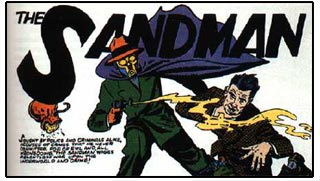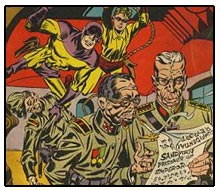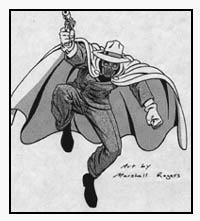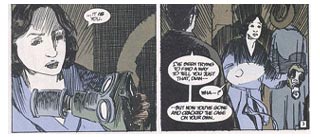|
Enter
Sandman
(first published Spring 1997 issue
of Once Upon A Dime)
A gas mask and a business suit. This is the costume
that the Golden Age Sandman wore to fight crime.
A gas mask and a business suit. Sounds absurd, right?
So why is the character so memorable and interesting?
 The
Sandman was a second-rate character for most of
his existence. First appearing in New York World’s
Fair Comics in 1939 in a story by Gardner Fox and
Bert Christman, Wesley Dodds was a millionaire inventor
who invented a gas gun that would force those exposed
to the gas to tell the truth. Donning his gas mask
and business suit, essentially street clothes, the
Sandman faced and defeated mainly ordinary criminals
in this phase of his career, albeit unusually sadistic
and cruel criminals. The
Sandman was a second-rate character for most of
his existence. First appearing in New York World’s
Fair Comics in 1939 in a story by Gardner Fox and
Bert Christman, Wesley Dodds was a millionaire inventor
who invented a gas gun that would force those exposed
to the gas to tell the truth. Donning his gas mask
and business suit, essentially street clothes, the
Sandman faced and defeated mainly ordinary criminals
in this phase of his career, albeit unusually sadistic
and cruel criminals.
One
of the first costumed characters to emerge from
DC Comics after the success of Superman, the Sandman
seems as much a pulp magazine character as a super-hero
as we think of them. Seen in this light, the idea
of wearing a gas mask and a business suit to fight
crime makes sense. He’s a transitional character
between pulp heroes like Doc Savage, the Shadow
and the Spider, and costumed crime-fighters such
as Batman and Captain America. After the World’s
Fair one-shot, Sandman began appearing in Adventure
Comics beginning in issue 40 from that same year.
 The
Sandman briefly was popular when comics were new,
appearing as a charter member of the Justice Society
in 1940 and appearing in the following 29 issues
of Adventure Comics in his unusual costume. However,
as new and more colorful characters continued to
appear, the Sandman seemed more and more like a
relic of times past. It was decided that the character
should be revamped, and in Adventure Comics #69,
1941, at the hands of artist Chad Grothkopf, he
donned a rather garish yellow and purple costume,
was given a teen sidekick, called Sandy, and even
gave up his gas gun. The
Sandman briefly was popular when comics were new,
appearing as a charter member of the Justice Society
in 1940 and appearing in the following 29 issues
of Adventure Comics in his unusual costume. However,
as new and more colorful characters continued to
appear, the Sandman seemed more and more like a
relic of times past. It was decided that the character
should be revamped, and in Adventure Comics #69,
1941, at the hands of artist Chad Grothkopf, he
donned a rather garish yellow and purple costume,
was given a teen sidekick, called Sandy, and even
gave up his gas gun.
In
late 1941, the team supreme of Joe Simon and Jack
Kirby were assigned to the strip, and its transition
from its pulp roots was complete. Instead of dark
and mysterious crime fiction, “Sandman”
became a classic Simon and Kirby all-action strip.
This transition helped the comic to survive the
World War II era by embracing many of the fashions
of the day.
By
1946, however, as the comics industry evolved away
from super-heroes, Sandman disappeared from sight.
He left the Justice Society in 1945, and appeared
his last in Adventure Comics, one year later with
issue #102.
 The
Sandman appeared again over twenty years later,
with the rest of his pals from the Justice Society,
in Justice League of America #46, 1966. That story
found the Sandman back in his original outfit of
a gas mask and business suit. He was an intriguing
character because of his unique look, but always
seemed to keep pretty much to the background. In
JLA #113, he did step to the forefront as the fate
of his partner Sandy was resolved, but despite his
unique look, the Golden Age Sandman was always a
secondary player in the JLA/JSA team-ups. The
Sandman appeared again over twenty years later,
with the rest of his pals from the Justice Society,
in Justice League of America #46, 1966. That story
found the Sandman back in his original outfit of
a gas mask and business suit. He was an intriguing
character because of his unique look, but always
seemed to keep pretty much to the background. In
JLA #113, he did step to the forefront as the fate
of his partner Sandy was resolved, but despite his
unique look, the Golden Age Sandman was always a
secondary player in the JLA/JSA team-ups.
When the JSA stepped into their own series with
All-Star Comics #57 in 1976, the Sandman wasn’t
one of the featured players. The writing was on
the wall and Wesley Dodds looked to be headed to
the limbo of forgotten comics characters.
Forgotten,
that is, until a new, or rather very old, character
called the Sandman began appearing in his own series
beginning in 1988. You may have heard of this series
– written by Neil Gaiman, Sandman was one
of the most critically-acclaimed and popular comics
of the 1990s. One of the key points of the series
was that Morpheus, Dream of legend, had been imprisoned
for 70 years in a crystal by an Aleister Crowley
analogue who actually was trying to trap Dream’s
sister Death. In Dream’s absence, the horrors
of the 20th century were unleashed. World War I,
the Holocaust, Vietnam – these horrific events
occurred because dreams were out of control since
they had lost their master.
One
other side effect was that some dreams leaked out
to minds that were sensitive to the vibrations of
the Dreaming. One of those men was millionaire Wesley
Dodds, who in the 1930s dreamed of horrific crimes
and was compelled to fight them. Donning a gas mask,
an analogue to Morpheus’s battle mask, and
carrying a gas that forces those who breathe it
to tell the truth, Dodds was compelled to fight
evil acts that occur in and around New York City.
Emerging in 1939 to fight the serial murderer The
Tarantula, Dodds was a crimefighter driven by his
own nightmares to end the nightmares of others.
He simply had no choice but to fight crime. It was
either that, or go crazy.
When
the Vertigo line began in 1993, it was decided that
a spin-off series of Sandman would appear featuring
the adventures of Wesley Dodds. In the hands of
writers Matt Wagner and Steve Seagle, as well as
artist Guy Davis, who drew most of the issues, Sandman
Mystery Theatre presented gritty crime stories set
in the 1930s. Each story was created as a four-issue
arc, which was both a nod to the pulp style of the
1930s and also served to allow each story room to
breathe.
Wesley
Dodds was never exactly the model of a modern crime
fighter. Pudgy and wearing glasses, he hardly had
the body of a Greek god. Further, though he did
fight crime to stop evil-doers, he did so as much
out of a compulsion to end his emotional torture
as a compulsion to end evil. And finally, he was
never either a friend of an enemy of the police.
Instead both sides seemed to size each other up
warily, as if never quite trusting each other.
To top it off, the police commissioner was the father
of Wesley’s paramour Dian Belmont. After a
short time dating, Dian learns of Wesley’s
secret identity and secretly supports his wearing
of the mask while simultaneously trying to love
and respect her father.

Dian
is perhaps the most interesting character in the
series. One could certainly make the argument that
she’s the most intelligent character in the
series, and the one who grows the most as the series
progresses. Dian allows circumstances to shape her
opinions and forms conclusions about events only
when evidence points her in a certain direction.
Later in life she would become a famous writer –
in fact, when Jack Knight, the Starman, meets Wesley
and Dian in the pages of his 1990s series, he is
more excited to meet the famous writer than he is
in meeting the former member of the Justice Society.
And
there lies the secret of both why Sandman Mystery
Theatre was such a fine series, and why Wesley Dodds
is so forgettable. Wagner and Seagle created wonderful,
unique characters in Wesley and Dian, and their
relationship was one of the most intelligent in
comics – they were adults who loved each other
as adults. Dodds was a great crimefighter, but that
was all he was. Dian, on the other hand, was by
the end of SMT’s run both a great crimefighter
and great author in training. Her experiences made
great art; Dodds’ experiences made great pulp
comics. He was forced to fight crime due to his
horrific dreams; Dian fought crime because she was
intelligent and good at it.
I
realize it seems I’m putting down Dodds as
I describe this comic. He’s a multifaceted
and interesting character. But the real hero of
Sandman Mystery Theatre, the one who really grows,
is his loving companion.
Seagle
and Davis were given the opportunity to wrap up
the series with issue 70, and it’s there that
Dodds manages to show his real heroism. After he
receives a telegram from his brother, who is caught
in the Warsaw Ghetto at the dawn of the Second World
War, Dodds decides he must fly to Europe and try
to help his brother and other people who are having
horrific experiences at the hands of the Nazis.
He gives up his comfortable life to do something
truly good in his life. It’s a transcendent
way to end a remarkable series. Sandman Mystery
Theatre may be a long-gone continuity implant from
the early days of Vertigo. But it is an intelligent,
thoughtful series well worth searching out.
--Jason
Sacks
Read more articles
by Jason at his website

|